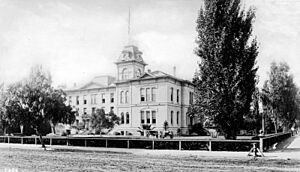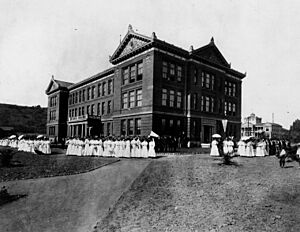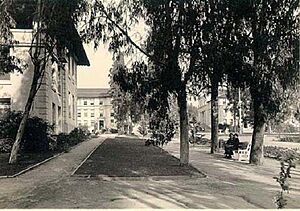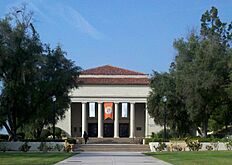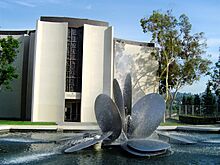Occidental College facts for kids
 |
|
| Motto | Occidens Proximus Orienti (Latin) |
|---|---|
|
Motto in English
|
The West is nearest the East |
| Type | Private liberal arts college |
| Established | April 20, 1887 |
|
Religious affiliation
|
Non-sectarian (historically Presbyterian) |
|
Academic affiliations
|
|
| Endowment | $575.8 million (2021) |
| President | Tom Stritikus |
|
Academic staff
|
276 (fall 2023) |
| Students | 1,854 (fall 2023) |
| Location |
Los Angeles, California
,
U.S.
34°07′38″N 118°12′39″W / 34.1271°N 118.2109°W |
| Campus | Urban, 120 acres (49 ha) |
| Colors | Orange and black |
| Nickname | Tigers |
|
Sporting affiliations
|
NCAA Division III – SCIAC |
| Mascot | Oswald the Tiger |
Occidental College, often called Oxy, is a private college in Los Angeles, California. It's a special kind of school called a liberal arts college. This means students learn about many different subjects, not just one.
Occidental College was started in 1887 by a group of church leaders. It was open to both boys and girls from the beginning. In 1910, it became a non-religious school. It is one of the oldest liberal arts colleges on the West Coast of the United States.
The college's campus is about 120 acres (49 hectares) and is in the Eagle Rock, Los Angeles area. A famous architect named Myron Hunt designed it. Because it's close to Hollywood and has cool buildings, the campus is often used for filming movies and TV shows.
Occidental is a founding member of the Southern California Intercollegiate Athletic Conference. Its 20 sports teams compete in NCAA Division III. The college teaches students to think about different cultures, understand the world, and be active in their communities.
Many famous people have gone to Occidental College. This includes former U.S. President Barack Obama. Other notable alumni include people who became government leaders, company CEOs, and winners of major awards like the Pulitzer Prize and Academy Awards.
Contents
College History
How Occidental Started
Occidental College began on April 20, 1887. It was founded by a group of church leaders and other important people. The first building was started in September 1887 in the Boyle Heights area of Los Angeles.
The college opened a year later with 27 male and 13 female students. The cost for a year of school was $50.
In 1896, the first building was destroyed by a fire. The college moved to a temporary spot. Then, in 1898, a new location was chosen in Highland Park, Los Angeles. Here, three main buildings were built. One of these buildings, the Hall of Arts and Letters, is still standing today.
The Highland Park campus was near train tracks. Two U.S. Presidents visited the campus there: William Howard Taft in 1909 and Theodore Roosevelt in 1911.
In 1909, there was an idea to combine Occidental with Pomona College, but it didn't happen. The next year, Occidental officially became a non-religious school. The Highland Park campus was small, and the trains were noisy. So, the college decided to find a new home.
Moving to Eagle Rock
In 1912, construction began on the new campus in the Eagle Rock neighborhood. This campus was designed by Myron Hunt. He also planned the California Institute of Technology (Caltech) campus.
That same year, the college president wanted to make Occidental an all-boys school. But students and teachers protested, and the idea was dropped.
New buildings were opened in 1914 at the Eagle Rock campus. Patterson Field, one of the oldest college sports stadiums in Los Angeles, opened in 1916. During World War I, the college helped the war effort by forming a student army training group.
Growth and Changes
In the 1920s, more new buildings designed by Myron Hunt were added. These included the Clapp Library and the Alumni Gymnasium. In 1926, Occidental became home to a special academic honor society called Phi Beta Kappa. At that time, only a few other colleges in California had this honor.
During World War II, many students left to fight. The U.S. Navy even had a training program on campus. The college president, Remsen Bird, also helped Japanese American students continue their studies during this time.
In 1958, two Occidental students, John Paden and Aaron Segal, won Rhodes Scholarships. This is a very important award for students to study in England. They were also part of a program called Crossroads Africa, which was like an early version of the Peace Corps.
In 1969, some students were suspended for protesting military recruiting. The next year, classes were stopped after the Kent State shootings. Students wrote many letters to protest the war in Southeast Asia. Occidental also started one of the first Upward Bound programs. This program helps high school students from low-income families be the first in their family to go to college.
In the late 1960s and early 1970s, the college opened its first dorms where both boys and girls lived. In 1988, John Brooks Slaughter became Occidental's first Black president. He helped create a new mission statement for the college that is still used today. He also expanded the college's community service programs.
In 1990, the main chapel on campus was renamed the Herrick Memorial Chapel and Interfaith Center. The crosses were removed to welcome students of all religions.
Occidental in the 2000s
In 2006, Susan Westerberg Prager became Occidental's first female president. She left in 2007. In 2009, Jonathan Veitch became the 15th president.
In 2014, the college worked to improve how it handled issues of student safety. It created new policies and hired a special coordinator to help students.
Former U.S. President Barack Obama attended Occidental for two years before transferring to another university.
In July 2020, Harry J. Elam Jr. became Occidental's 16th president. He retired in 2024. On March 26, 2024, it was announced that Tom Stritikus would become Occidental's new president starting July 1, 2024.
Campus Life and Buildings
Myron Hunt designed the original plan for Occidental's campus in 1911. He used a Mediterranean style with covered walkways and tile roofs. All 19 buildings he designed are still used today.
The campus has an outdoor Remsen Bird Amphitheater. Plays and musicals were performed there for many years. Now, the Occidental Children's Theater performs there every summer.
Newsweek magazine called Occidental College the sixth "Most Beautiful" campus in 2012. The campus also has a large solar array on a hillside. This helps power the college with clean energy.
Academics and Learning
Occidental College offers more than 40 main subjects to study. There are also nine minor subjects, like Public Health and Linguistics. The college has a small student–faculty ratio of 9 students for every 1 teacher. This means classes are usually small, with about 18 students. Most students take four classes each semester.
Some of the most popular subjects for students who graduated in 2021 were Economics, Psychology, Biology, Political Science, and Environmental Studies.
College Rankings
| USNWR Liberal Arts College | 34 |
|---|---|
| Washington Monthly Liberal Arts | 46 |
| Forbes | 102 |
Occidental College is known for its strong academics. Since 1908, ten students from Oxy have won Rhodes Scholarships. These are very competitive awards to study at Oxford University in England.
In the 2025 rankings by U.S. News & World Report, Occidental was tied for 34th among all liberal arts colleges in the U.S. It was also ranked highly for helping students from different backgrounds succeed.
How to Get In
Occidental College is a selective school. For the class that started in 2020, about 37% of students who applied were accepted. Many of the accepted students were in the top 10% of their high school class.
In 2023, Occidental announced a change in its admissions process. It stopped giving special preference to children of alumni. This means that all applicants are now judged more equally.
Student Life
At the start of each school year, new students take part in a special ceremony called convocation. Teachers wear their fancy academic robes, and students wear robes too. Founders Day is celebrated every year on April 20, which is the day the college officially started in 1887.
Occidental has special living communities in its dorms. These include a Multicultural Hall, housing just for women, and houses that support students of color and LGBTQIA students.
Campus Media
The Occidental is the college's student newspaper. It has been published by students since 1893.
KOXY is the student-run campus radio station. It started in the 1960s and has been back on air since 2000. It now broadcasts online. KOXY also helps with events on campus.
In 2010, students started a TV station called CatAList. Students create 20-30 minutes of TV content each week.
Student Groups
Occidental College has several fraternities and sororities. These are social groups that students can join.
Sports and Athletics
Occidental College is one of the five schools that started the Southern California Intercollegiate Athletic Conference (SCIAC) in 1915. It is part of NCAA Division III. Occidental has 21 different sports teams. About 25% of students play on a varsity sports team.
The college also has club sports and intramural competitions, which are sports played just for fun among students.
Occidental's sports history goes back to 1894. Since then, many Oxy athletes have become Olympians, world-record holders, and national champions. This includes two-time diving gold medalist Sammy Lee.
Occidental has long-standing football rivalries with Pomona College and Whittier College. The Tigers have played these teams over 100 times. In 2020, the college stopped its football program.
In 2011, the Occidental Men's Basketball team lost a game to Caltech. This was a big deal because it was Caltech's first conference win in 26 years! In 2019, the Occidental Men's Basketball Team reached the SCIAC championship game.
Famous athletes from Occidental College include NFL coach Jim E. Mora and former NFL player Jack Kemp.
Notable People
-
Barack Obama, 44th U.S. President (transferred)
-
Eric Garcetti, 42nd Mayor of Los Angeles (Professor)
-
Jack Kemp, former U.S. government official and NFL player
-
Robert Finch, former government official
-
Terry Gilliam, BAFTA-winning filmmaker and former member of Monty Python
-
Ben Affleck, actor and Academy Award-winning filmmaker (did not graduate)
-
Luke Wilson, actor (did not graduate)
Many interesting people have studied or taught at Occidental College.
Some famous graduates include:
- Filmmaker Terry Gilliam
- Football player and politician Jack Kemp
- Physicist and inventor George Edward Alcorn Jr.
- Former NFL coach Jim E. Mora
- Civil rights activist Ernesto Galarza
- Actress Joanna Gleason
Some notable people who attended Occidental but did not graduate include:
- Barack Obama, the 44th U.S. President
- Ben Affleck, an actor and filmmaker
- Luke Wilson, an actor
- Nicholas Braun, an actor
- Emily Osment, an actress
Famous teachers at Occidental have included:
- Urban policy expert Peter Dreier
- Former U.S. Ambassador to Finland Derek Shearer
- Chemist Frank L. Lambert
See also
 In Spanish: Occidental College para niños
In Spanish: Occidental College para niños


